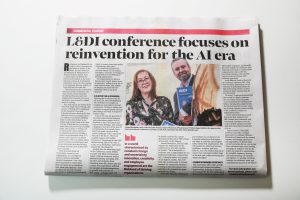In the age of intelligent machines, HPC’s Kevin Hannigan explores the importance of adopting a human-centred approach to learning that puts people development and growth first.
In a world transformed by intelligent technologies, how we approach learning is undergoing seismic shifts. Automation and AI are reshaping not just what we learn but how we learn, presenting both unprecedented opportunities and critical challenges. At this pivotal moment, it is essential to adopt a human-centred approach to learning—one that places people, their growth, and their ability to thrive at the heart of organisational strategy.
Peter Senge’s seminal work, The Fifth Discipline: The Art & Practice of The Learning Organization, provides a timeless framework to guide us in this endeavour. Senge’s concept of a learning organisation remains profoundly relevant. As intelligent machines increasingly permeate our workplaces, the principles articulated in the The Fifth Discipline can help us move from distributing knowledge to designing learning that reflects how humans learn best.
Reframing Learning in the Era of AI
While AI excels at processing information and delivering precise, targeted training, it lacks the nuance to foster the deeper connections and adaptive thinking that humans require. The challenge is not just to disseminate information but to ask, “How should people learn?”
We know from decades of research that humans thrive on experiential, collaborative, and contextual learning. Unlike machines, we are driven by curiosity, reflection, and social interaction. To leverage this, organisations must shift their focus from delivering training to creating ecosystems where people can actively engage, explore, and develop skills that resonate beyond automation.
This formula does not apply to all learning that takes place in an organisation. There remains a strong case for utilising technology, and particularly AI, for simple information and skills. “Learning in the flow of work” as envisaged by Josh Bersin can be brought to life far more effectively through the targeted use of AI.
However, for more complex skills, for sense-making activities and building connection, we need to think again about how people learn. To do this, we can explore some of the principles that Senge believed were at the heart of the “Learning Organisation”.
Personal Mastery: The Foundation of Human Learning
Senge highlights personal mastery as the cornerstone of the learning organisation. It’s about fostering a culture of continual self-improvement, where individuals take ownership of their growth. In a human-centred approach, this means providing learners with opportunities to:
Learn through Practice: Whether it’s role-play, simulations, or hands-on projects, embedding practical experiences ensures knowledge is internalised.
Reflect and Adapt: Building in reflection time helps learners make sense of their experiences, connect theory with practice, and develop critical thinking.
Set Learning Goals: Encouraging individuals to align learning with their personal aspirations ensures that growth is meaningful and self-directed.
Team Learning: Harnessing Collective Intelligence
Machines process data individually, but humans flourish when learning collaboratively. Senge’s principle of team learning is particularly vital in our interconnected workplaces. Organisations can foster this by:
Creating Safe Spaces for Dialogue: Environments where teams can question assumptions, share perspectives, and build shared understanding promote innovative problem-solving.
Fostering Peer Learning: Collaborative projects and mentoring networks enable employees to learn from one another, leveraging diverse skills and experiences.
Embedding Social Technologies: Intelligent platforms that facilitate team collaboration and real-time feedback can complement human learning without overshadowing it.
Mental Models: Challenging Assumptions
To adopt a human-centred approach, organisations must help learners identify and challenge these assumptions. Encourage:
Exploration of New Perspectives: Use storytelling and case studies to expose learners to diverse viewpoints and complex scenarios.
Critical Thinking Exercises: Empower individuals to question the status quo, evaluate evidence, and make ethical decisions.
Adaptive Learning Pathways: Tailored experiences that evolve with the learner’s growth encourage flexible, open-minded thinking.
Balancing Technology with Humanity
Finally, while technology plays a crucial role in advancing learning, it is a tool —not a substitute —for human growth. The most effective organisations will integrate AI to enhance, not replace, human-centred learning. For example:
AI as a Coach: Intelligent systems can provide personalized feedback and recommendations, freeing up mentors to focus on deeper, relationship-driven guidance.
Insights from Data: AI can help identify learning trends and gaps, allowing L&D teams to target the most critical issues.
AI as Prompt: In complex environments, AI can guide and prompt individuals through the process, reducing time spent learning complex procedures and minimising the risk of error.
From Distribution to Discovery
Moving forward, the question is no longer about how we distribute learning but how we create opportunities for discovery. As intelligent technologies reshape our world, the value of human skills—connection, creativity, critical thinking—will only grow. By embracing Senge’s principles of the learning organisation and designing learning experiences that align with the way humans learn, we can ensure that our workforce is not only prepared for the future but inspired to shape it.
In this era of transformation, the most powerful investment we can make is in human potential. By fostering environments that support meaningful learning, we will empower individuals to thrive in a world where machines are intelligent, but our essential humanity remains.
Kevin Hannigan – HPC
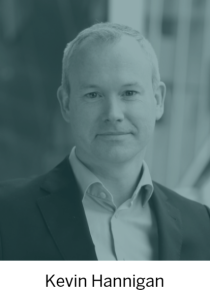
Kevin leads the Learning and Talent Consulting offering and is also a Client Director at HPC. He works with clients to develop, deliver and evaluate bespoke solutions that drive performance across their business.
He is a highly skilled consultant and facilitator with a wealth of experience in designing the systems and processes that support effective learning, measurement and talent development.
Before joining HPC in 2013, Kevin was head of learning and development for Matheson, Ireland’s largest law firm and for C&C Ireland.
kevin.hannigan@wearehpc.com
Connect with Kevin on LinkedIn >>>
Connect with HPC on LinkedIn >>>


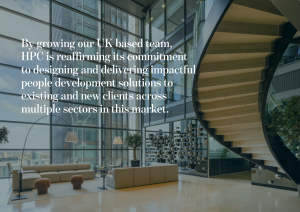 We will also be working more regularly from our new London base in Heron Tower, Bishopsgate. Located on the northeastern corner of the financial hub of the City, its central location allows us to connect with existing and new clients.
We will also be working more regularly from our new London base in Heron Tower, Bishopsgate. Located on the northeastern corner of the financial hub of the City, its central location allows us to connect with existing and new clients.

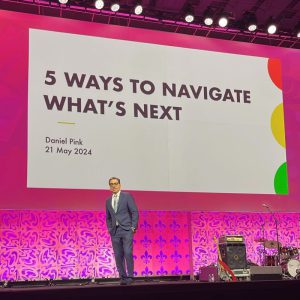
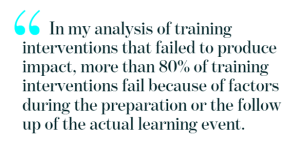 Kevin then asked Robert about what drives learning transfer. In Robert’s view, many factors drive learning transfer, some of which happen before the learning takes place, and some of which take place after the learning. In Robert’s experience, about 80% of the impact of learning depends on these before and after elements. Some specific considerations that Robert highlighted are:
Kevin then asked Robert about what drives learning transfer. In Robert’s view, many factors drive learning transfer, some of which happen before the learning takes place, and some of which take place after the learning. In Robert’s experience, about 80% of the impact of learning depends on these before and after elements. Some specific considerations that Robert highlighted are: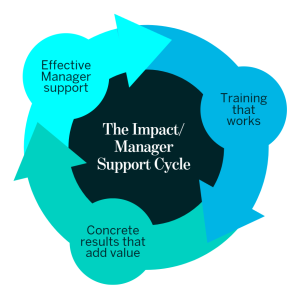 Kevin noted how these elements suggest that the involvement and support of the learner’s line manager is key, and probed Robert a little more on this. Robert emphasised that the manager is key to the learner developing a sense of accountability for applying their learning and that this, in turn, depends on there being a dialogue with the manager before and after the learning. Robert noted how often “most people are held accountable for participating” but that this is not enough for learning to deliver real and consequential value to the organisation.
Kevin noted how these elements suggest that the involvement and support of the learner’s line manager is key, and probed Robert a little more on this. Robert emphasised that the manager is key to the learner developing a sense of accountability for applying their learning and that this, in turn, depends on there being a dialogue with the manager before and after the learning. Robert noted how often “most people are held accountable for participating” but that this is not enough for learning to deliver real and consequential value to the organisation.
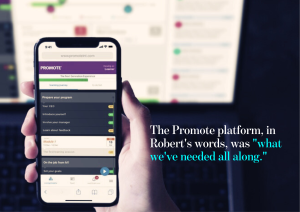 The final part of the discussion explored the value of the Promote platform. HPC uses Promote to facilitate learning transfer for clients and to create a compelling blended experience for programme participants. Since starting to use the platform in 2016, it has supported thousands of learners to continue their learning journey beyond the “classroom”. Kevin first came across the Promote platform when reading a report that Robert had joined the company as an advisor and he was curious as to how Robert had become involved. Robert first encountered the platform after he had retired, noting that for most of his career training was event-focused. Robert knew of the importance of the before and after factors that wrap around a training event, as well as the reliance on managers, all of which was hard to do. The Promote platform, in Robert’s words, was “what we’ve needed all along! When I saw it, I came off the retirement bench to get involved as much as I could in this promising technology!” The platform allows you to manage the before and after factors, giving you control and allowing you to connect with your learners in their workplace. Equally, there is no place to hide for a learner anymore because we can see it and do something about it. With Promote, learners are accountable for doing something useful with their learning.
The final part of the discussion explored the value of the Promote platform. HPC uses Promote to facilitate learning transfer for clients and to create a compelling blended experience for programme participants. Since starting to use the platform in 2016, it has supported thousands of learners to continue their learning journey beyond the “classroom”. Kevin first came across the Promote platform when reading a report that Robert had joined the company as an advisor and he was curious as to how Robert had become involved. Robert first encountered the platform after he had retired, noting that for most of his career training was event-focused. Robert knew of the importance of the before and after factors that wrap around a training event, as well as the reliance on managers, all of which was hard to do. The Promote platform, in Robert’s words, was “what we’ve needed all along! When I saw it, I came off the retirement bench to get involved as much as I could in this promising technology!” The platform allows you to manage the before and after factors, giving you control and allowing you to connect with your learners in their workplace. Equally, there is no place to hide for a learner anymore because we can see it and do something about it. With Promote, learners are accountable for doing something useful with their learning.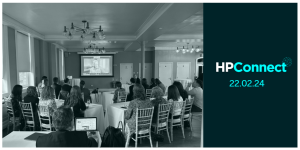 As Kevin and Robert wrapped up their conversation, Robert graciously took two questions from the audience. The first question to Robert was “if he felt that L&D professionals needed to become more sales and marketing-focused to sell the benefits of learning solutions to a business.” Robert emphasised the importance of L&D professionals using data to provide evidence that training pays off, and even to show when learning is not being fully utilised and how a business could get more from it. He used the term “User education” to remind us that learning doesn’t just work magically and that you need to do something with the learning to get value from it. Being able to show a manager what is working, and where there is value not being fully exploited is very impactful. He spoke about a shift in the “user” mindset about learning. Learning is no longer about filling seats but instead is concerned with making sure L&D provides value to our clients. He ended this response by urging L&D professionals to “market the bejesus out of learning to clients”.
As Kevin and Robert wrapped up their conversation, Robert graciously took two questions from the audience. The first question to Robert was “if he felt that L&D professionals needed to become more sales and marketing-focused to sell the benefits of learning solutions to a business.” Robert emphasised the importance of L&D professionals using data to provide evidence that training pays off, and even to show when learning is not being fully utilised and how a business could get more from it. He used the term “User education” to remind us that learning doesn’t just work magically and that you need to do something with the learning to get value from it. Being able to show a manager what is working, and where there is value not being fully exploited is very impactful. He spoke about a shift in the “user” mindset about learning. Learning is no longer about filling seats but instead is concerned with making sure L&D provides value to our clients. He ended this response by urging L&D professionals to “market the bejesus out of learning to clients”.

 When Bob Dylan released “The Times They Are A-Changin’” in 1964 it no doubt resonated with people who could see change happening all around them. History since then has taught us that every generation feels like this. Things are changing faster than ever before, and while we would like to stop all the change for a little while to draw breath, this simply isn’t going to be possible. So, as we face ever faster and more dramatic changes in our lives at work and home, we need to revisit our personal beliefs about change. While a yearning for stability and predictability is very human, not least because it tries to preserve scarce decisional resources, your brain is perfectly capable of learning, evolving, presenting you with decision options, and weighing risk. We can’t expect the level of change to lessen, so we must embrace the need for continuous change and personal evolution.
When Bob Dylan released “The Times They Are A-Changin’” in 1964 it no doubt resonated with people who could see change happening all around them. History since then has taught us that every generation feels like this. Things are changing faster than ever before, and while we would like to stop all the change for a little while to draw breath, this simply isn’t going to be possible. So, as we face ever faster and more dramatic changes in our lives at work and home, we need to revisit our personal beliefs about change. While a yearning for stability and predictability is very human, not least because it tries to preserve scarce decisional resources, your brain is perfectly capable of learning, evolving, presenting you with decision options, and weighing risk. We can’t expect the level of change to lessen, so we must embrace the need for continuous change and personal evolution.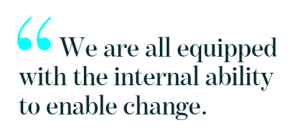 We might not all feel the same way about an upcoming change. We may not all relish the challenge of crisis or discontinuity. We can all cope with these challenges, but only by letting go of the worn-out belief that we can’t change. Our brains are designed to adapt, but our minds often try to avoid the work. In a world where more change is certain, embrace your own in-built capability to learn, try, fail, and ultimately change.
We might not all feel the same way about an upcoming change. We may not all relish the challenge of crisis or discontinuity. We can all cope with these challenges, but only by letting go of the worn-out belief that we can’t change. Our brains are designed to adapt, but our minds often try to avoid the work. In a world where more change is certain, embrace your own in-built capability to learn, try, fail, and ultimately change.

